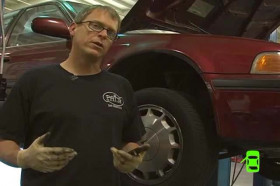How do brake pedals work? When you depress your brake pedal, your car transmits the force from your foot to its brakes through a fluid. Since the actual brakes require a much greater force than you could apply with your leg, your car must also multiply the force of your foot. Put it all together and here’s how car brakes work in a nutshell: drivers generate hydraulic pressure by pressing the brake pedal, and that pressure travels to the brake caliper (or drum ) at each.
The more pistons a caliper has the more evenly distributed the braking force is across the pa and the larger the pad surface can be. Look at the brakes on your bike.
See how when you pull the brake lever on the handle bars, the small black brake pads touch the rim of the wheel? In general, your foot presses the pedal, which presses fluid through tubes, which presses a brake pad against a brake rotor attached to your wheel.
The friction between the pad and rotor reduces your speed. So when the caliper is pressurize the pads clamp down on the rotors from the outside. Either way, it’s friction causing kinetic energy, stopping the car.

Disc brakes consist of a brake disc, a brake caliper, and a brake pad. When the brake pedal is depressed, the hydraulic fluid causes the brake caliper to press the brake pad against the brake disc. The rubbing of the brake pad against the brake disc generates friction, which converts kinetic energy into heat in the brake pad. A hydraulic brake circuit has fluid-filled master and slave cylinders connected by pipes.
Power-assisted brakes. Many cars also have power assistance to reduce the effort needed to apply the brakes. This system, known as hydraulics, greatly increases the force you supply.
They achieve this by using friction between a wheel and another object to stop the vehicle. When the driver presses the pedal, a piston inside the brake master cylinder pressurizes hydraulic fluid in the brake lines, which moves the pistons and pushes the pads into the rotor. Motorcycle brakes work on the same principle as automotive brakes: The transfer of an action from the driver into a force that stops the wheels. The brakes should respond instantly.
When the driver of car or truck applies the brakes all four wheels work together to slow or stop the vehicle. On a motorcycle, the front and rear brakes usually operate independently of each other.

Most modern vehicles use a brake system comprised of disc brakes. They are called such because they use force applied upon discs attached to the wheels to slow and stop a car. While some entry-level vehicles use drum brakes on the rear wheels, four-wheel disc brakes are commonly found on everything from family sedans, to trucks, to high-performance sports cars.
The physics of car brakes are pretty simple. To slow down and stop your car, your brake system turns kinetic energy (the movement of your wheels) into heat energy by way of friction applied by your brakes to the wheels.

Once all the kinetic energy of the wheels has been converted to heat energy by the brakes, your car stops. ABS and Parking Brakes Anti-lock braking systems (ABS) work by limiting, applying and releasing the pressure to any wheel that decelerates too quickly.
This allows maximum stopping force to be applied without the brakes locking-up and the car skidding. Your vehicle’s ABS tests itself each time the ignition is turned on. Animated video showing the working of braking system in a car. This lever input is converted to clamping force as the pistons move the brake pads to contact the rotor.
When the driver steps on the brake pedal, it compresses two master brake cylinders - one for the front wheels and one for the rear - which generate fluid pressure. Calipers can be fixed by a rigid mount to the frame or floating.
At the front, the system is very straightforward. The fluid pressure is delivered directly to the front brake callipers.
Instead of a conventional handbrake lever attached to a cable activating the parking brakes and holding the vehicle in place, the electric version merely requires the driver to flick a switch in the cabin. The electronic parking brake will usually be applied automatically when the vehicle is switched off or park (P) is engaged on an automatic car. On an electric car it simply draws energy off the motor, slightly topping up your batteries (not much though). This is how electronic brakes work.
There are ways of making brake pads last longer: Being aware of traffic ahea and anticipating potential braking situations, helps a driver to apply brakes steadily and. Avoid high speed driving thatin needing to brake heavily and quickly - sudden braking puts brake pads under. The Brakes are called overrun brakes. As the car slows down the trailer brakes are operated by a piston in the drawbar.
Compressing the front piston pulls a rod acctivating the drum brakes on each.

No comments:
Post a Comment
Note: only a member of this blog may post a comment.